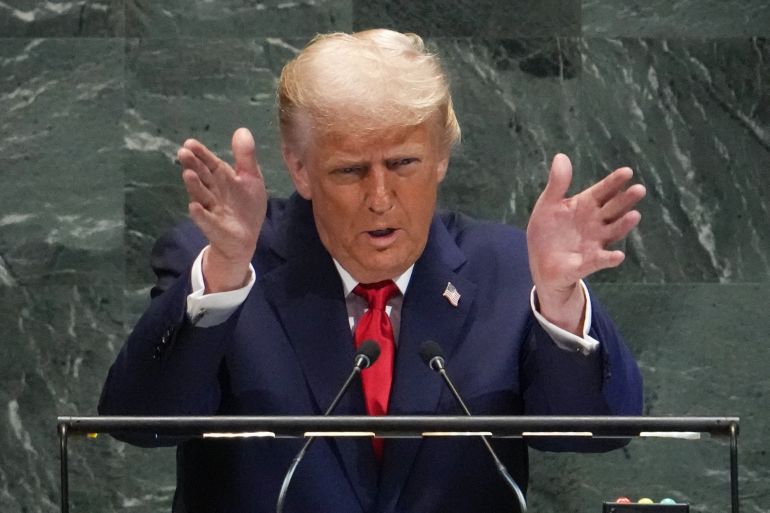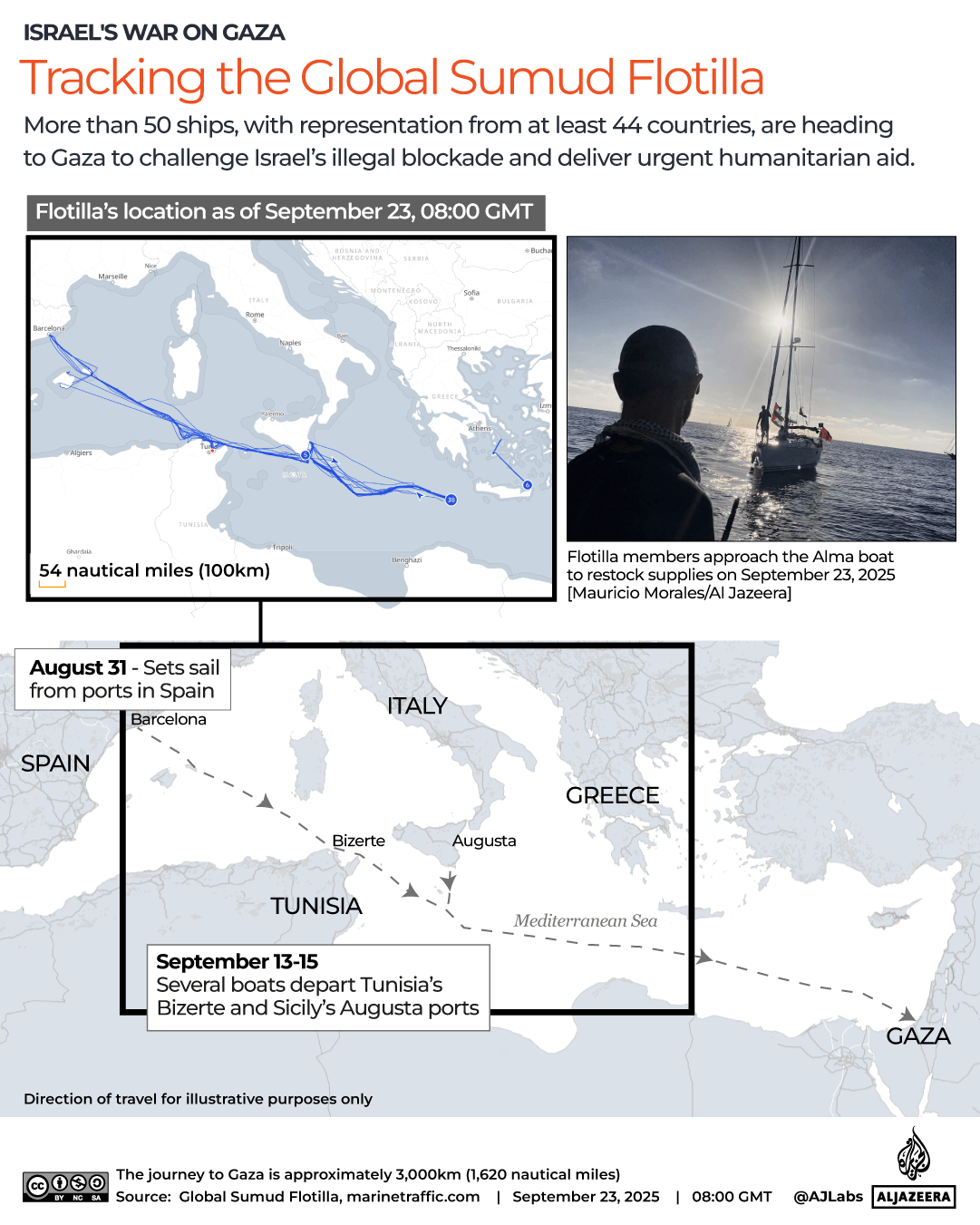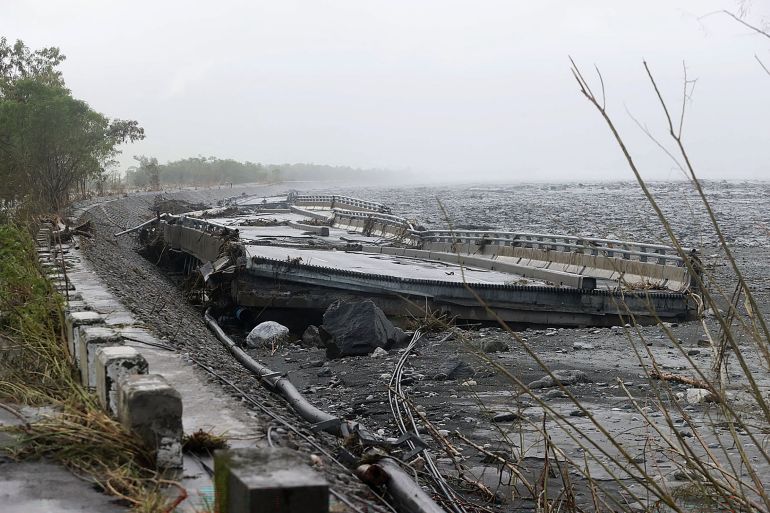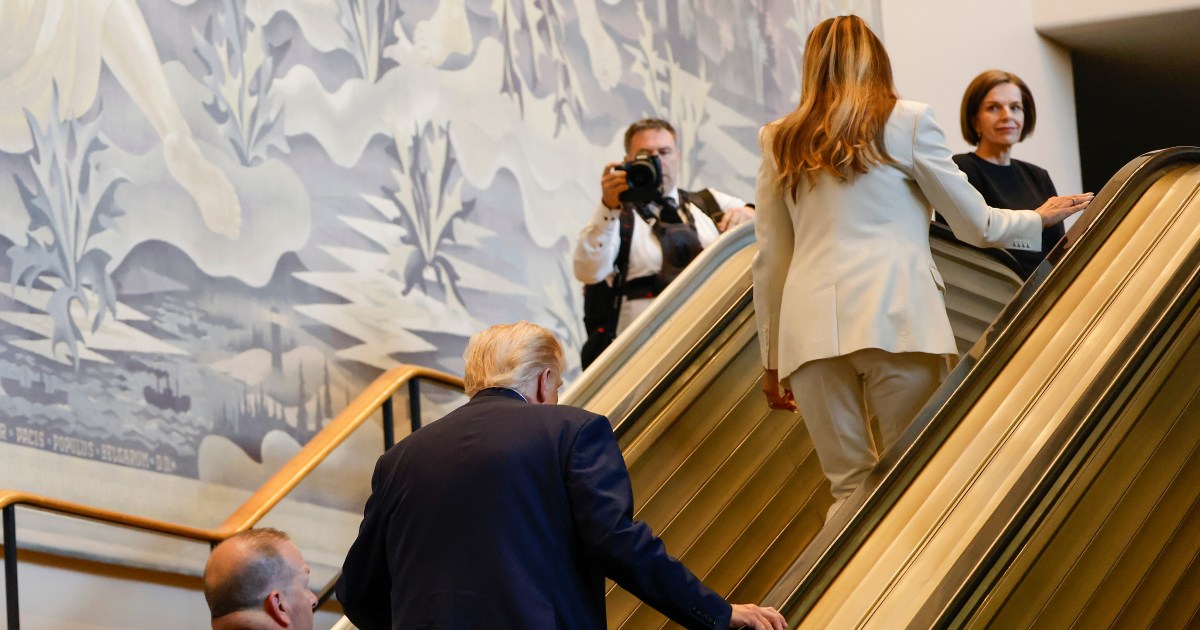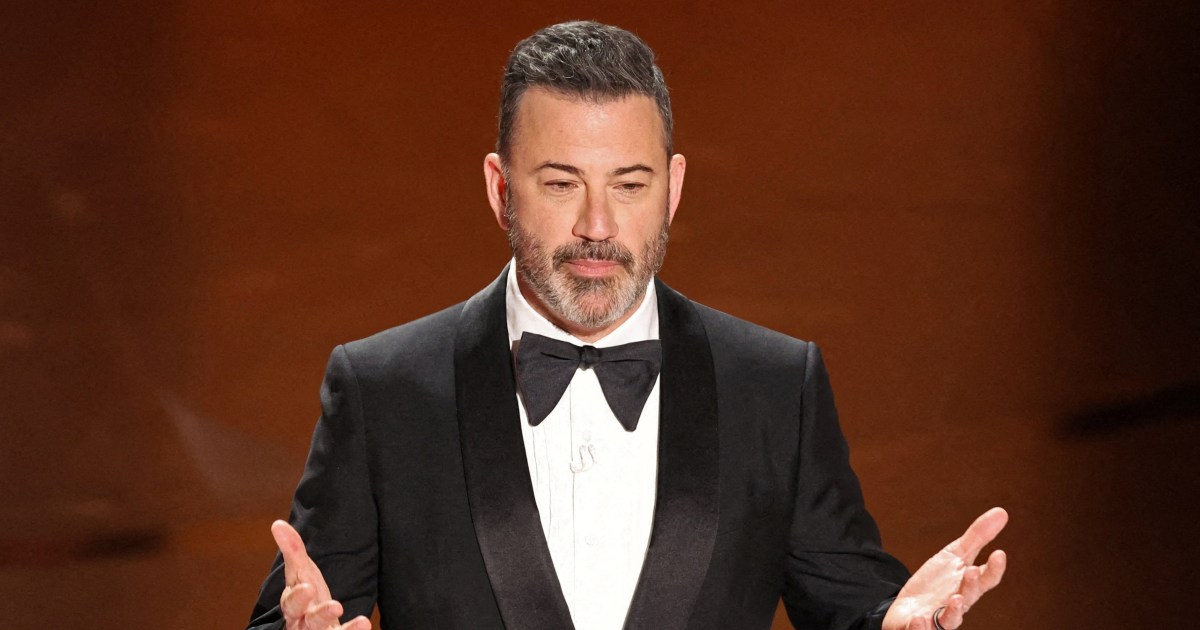Donald Trump, the president of the United States, delivered a powerful speech that covered topics such as immigration, climate change, immigration, and more. He attacked friends and rivals alike, while making controversial – and often factually inaccurate – assertions.
Here are some of his most important statements and arguments, and how they compare to the facts.
Broken teleprompter
Trump opened his speech by making a lighthearted observation about a broken teleprompter, noting that he didn’t mind if it wasn’t functioning.
“I don’t mind making this speech without a teleprompter, because the teleprompter is not working”, Trump said.
“I’m very happy to be here with you, but I’m not.” And that way, you speak more from the heart. Who is in charge of this teleprompter is in serious trouble, to my knowledge.
But a UN official said the teleprompter was being operated by the White House.
And as soon as Trump finished speaking, Annalena Baerbock, president of the UNGA, said, “I would like to assure you that, don’t worry, the UN teleprompters are working perfectly.”
Baerbock was Germany’s foreign minister until earlier this year.
‘ You’re destroying your countries ‘
Trump claimed that under his administration, nations that welcomed immigrants more than the US were “destroying” their nations.
“They’re being destroyed. Europe is in serious trouble. They’ve been invaded by a force of illegal aliens like nobody’s ever seen before. Immigration to Europe is rising rapidly.
Trump then referred to his administration’s policies towards migrants and asylum seekers.
I can tell you, “You must end it right away. I’m really good at this stuff. Your nations will end in a pit.
“Once we started detaining and deporting everyone who crossed the border, and removing illegal aliens from the United States, they simply stopped coming”, he said.
He added that in his earlier speeches, there had been no illegal aliens admitted to and entering our country for the first four months in a row.
Trump’s claims about undocumented migrants – some of whom cross the border seeking asylum – whom he calls “illegal”, are an exaggeration.
Border crossing apprehensions across the country decreased from 60, 600 in August of this year to roughly 8, 200 in July of this year, according to US Customs and Border Protection. This is one of the lowest monthly totals in decades, but it is not close to zero.
Russia under pressure: “Europe has to step up.”
Trump criticised Washington’s NATO allies for continuing to buy Russian energy, while urging Europe to step up pressure on Moscow over its war on Ukraine.
Trump claimed that even NATO countries have not cut off much of Russian energy and Russian energy products, but that China and India continue to be the main donors of the ongoing conflict.
As Al Jazeera reported in August, after the US doubled its 25 percent tariffs on Indian imports to 50 percent as punishment for New Delhi’s continued oil purchases from Russia, the European Union actually trades even more with Moscow.
The current level of trade between the EU and Russia is about a quarter of what it was before Russia’s full-fledged conflict with Ukraine (257.5 billion euros ($297.5 billion) in 2024). But this is still more than India’s total trade with Russia in 2024-25, which was worth $68.7bn.
And in comparison to the year before, Europe’s imports of Russian LNG increased by 9% in 2024.
Meanwhile, the US also imports a range of chemicals from Russia. The US Trade Representative’s Office estimates that total Russian-US trade in 2024 was $5. 2 billion, but this figure is significantly lower than that of 2021, when trade in goods was $36 billion.
Trump warned that the US is prepared to impose a new round of tariffs on Russia if no agreement is reached to end the war.
“European nations – all of you are gathered here right now – would have to join us in adopting the exact same measures,” Trump said.
“I mean, you’re much closer to this. We have an ocean in between, you see. You’re right there, and Europe has to step it up. They are unable to continue doing what they are doing, he continued.
‘ The greatest con job ever ‘
Trump also brought up climate science, which he had previously criticized.
“If you look back years ago, in the 1920s and the 1930s, they said global cooling will kill the world”, Trump said.
They then claimed that global warming would end the world, but things started to get worse. So now, they just call it climate change because that way, they can’t miss. Because climate change is inevitable regardless of whether it rises or falls precipitously.
“It’s the greatest con job ever perpetrated on the world, in my opinion. You are a participant in climate change, regardless of what transpires. No more global warming, no more global cooling. All of these predictions made by the UN and many others, often for false, were incorrect.
Trump at UNGA: Climate change— it’s the greatest con-job ever perpetrated on the world. pic . twitter.com/0vOknp9M2O
“If you don’t get away from this green scam, your country is going to fail, and I’m really good at predicting things”, he added.
His remarks coincide with the UNGA’s call for countries to present updated decarbonization targets, which would rekindle the momentum of the global fight against climate change.
Scientific evidence – including that touted by parts of Trump’s own administration – shows that global warming, along with its impacts on rising temperatures, shifting oceans, extreme weather and wildfires, is unfolding faster than previously expected.

‘ I ended seven wars ‘
Trump portrayed himself as a global peacemaker.
“I ended seven wars. And they were always raging, killing countless thousands of people. This includes Cambodia and Thailand, Kosovo and Serbia, the Congo and Rwanda – a vicious, violent war that was – Pakistan and India, Israel and Iran, Egypt and Ethiopia, and Armenia and Azerbaijan”, Trump said.
“That’s never existed before.” Very honoured to have done it. He said it was unfortunate that I had to do these things myself rather than the UN.
“And sadly, in all cases, the United Nations did not even try to help in any of them… All I got from the United Nations was an escalator that, on the way up, stopped right in the middle”.
Some nations have refuted Trump’s claims, despite the fact that he has been given credit for putting an end to the conflicts he listed. India, in particular, has publicly, and repeatedly, insisted that its May clash with Pakistan ended through bilateral conversations between the militaries of the South Asian neighbours, not any US mediation.
Trump’s supporters, however, have called him the “peace president” and argued that he merits a Nobel Peace Prize.
The UN has not been there for us as a country. Without any assistance, @POTUS has been negotiating peace for months in significant global conflicts.
The UN has tremendous potential, but it is not living up to it. Words that are frequently used are nothing more than empty words. Actions end wars. pic . twitter.com/fhvLmJceQK
On Iran strike and peace push
Trump cited the US’s military action against Iran’s nuclear sites as evidence of US strength, claiming that it had aided him in putting an end to the Israeli-Iranian military clashes in June.
“I extended a pledge of full cooperation in exchange for a suspension of Iran’s nuclear programme”, Trump said.
The regime responded by continuing to threaten their neighbors and US interests in the area.
“And three months ago in Operation Midnight Hammer, seven American B-2 bombers dropped the fourteen 30, 000-pound-each (13, 600kg) bombs on Iran’s key nuclear facility, totally obliterating everything”, Trump said.
We detest using them, but for 22 years people have wanted to do something. With Iran’s nuclear enrichment capacity demolished, I immediately brokered an end to the 12-day war, as it’s called, between Israel and Iran, with both sides agreeing to fight… no longer”, he added.
Mehdi Mohammadi, an adviser to the Iranian parliament’s chairman at the time, claimed that the US attack was not unexpected and that no irreparable harm was caused by the strikes. He added that authorities had evacuated all three nuclear sites that were bombed, in advance.
Trump claims that Hamas benefits from acknowledging the Palestinian state.
Trump condemned mounting efforts to recognise a Palestinian state, accusing Hamas of blocking peace and demanding the release of captives being held in Gaza.
The state of Palestine has been recognized by Australia, Andorra, Belgium, Canada, France, Luxembourg, Malta, Monaco, Portugal, and the United Kingdom as of this week.
“Hamas has repeatedly rejected reasonable offers to make peace”, Trump said.
He questioned “We can’t forget October 7th,” referring to the Hamas attack in southern Israel in 2023, which led to Israel’s brutal occupation of the Gaza Strip.
“Now, as if to encourage continued conflict, some of this body is seeking to unilaterally recognise a Palestinian state. Trump remarked that Hamas terrorists’ atrocities would be too much for them to bear.
“This could have been solved so long ago. But Hamas’s demands for ransom should be ignored by those who want peace, he continued, saying release the hostages right away.
Hamas on Tuesday refuted any responsibility for the failure to reach a deal to end the war in Gaza. In a statement, it stated that “we have never been a barrier to reaching an agreement.”
“The US administration, the mediators and the world know that Netanyahu is the sole obstructionist in all attempts to reach an agreement”, it added, referring to Israeli Prime Minister Benjamin Netanyahu.
Netanyahu has vowed to commit to a full withdrawal, despite Hamas’ declaration that it is ready for a truce that will result in the release of Palestinian prisoners and captives in Israeli jails.
This month, Israel launched a ground invasion to occupy Gaza City, killing hundreds of Palestinians and displacing tens of thousands. In total, more than 60, 000 Palestinians have been killed by Israel’s war against Gaza since October 2023, and food and aid restrictions have been in place there.
On drug traffickers: ‘ We will blow you out of existence ‘
Trump defended the contentious US military’s recent attacks on boats carrying what he claimed were Venezuelan drug traffickers, which have resulted in at least 17 fatalities.
“Let’s put it this way: People don’t like taking big loads of drugs in boats any more”, Trump said.
“Venezuela is not using too many boats to travel on the seas.” They tend not to want to travel very quickly any more. And we’ve effectively stopped sea-based drug trafficking in our nation. We call them the water drugs”, he added.
Experts question whether US attacks on foreign ships in international waters are legal. Data from both the UN and the US itself suggest that Venezuela is not a major source of cocaine coming in the US, as Trump has claimed.
Trump continued, “I’ve also designated two bloody transnational gangs, probably the worst gangs anywhere in the world, MS13 and Tren de Aragua,” as separate terrorist organizations.
“They’re the enemies of all humanity. And for this reason, we’ve recently begun using the military’s top ranks to defuse Venezuelan terrorists and trafficking organizations under the leadership of [President] Nicolas Maduro.
The Trump administration has not provided evidence linking Maduro to Tren de Aragua or any other drug cartel, and the Venezuelan leader has denied the allegations. Additionally, claims that Venezuela’s government and the gang have ties to one another have been disproven by the US intelligence community.

“We don’t have a choice, and we can’t let it go.” They’re destroying – I believe we lost 300, 000 people last year to drugs – 300, 000 – fentanyl and other drugs. More than 25 000 Americans would be killed by the drugs that we ship each day. We will not let that happen”, Trump said.
According to the US Drug Enforcement Administration, Mexico is the source of the majority of fentanyl traffic in the US [PDF].
